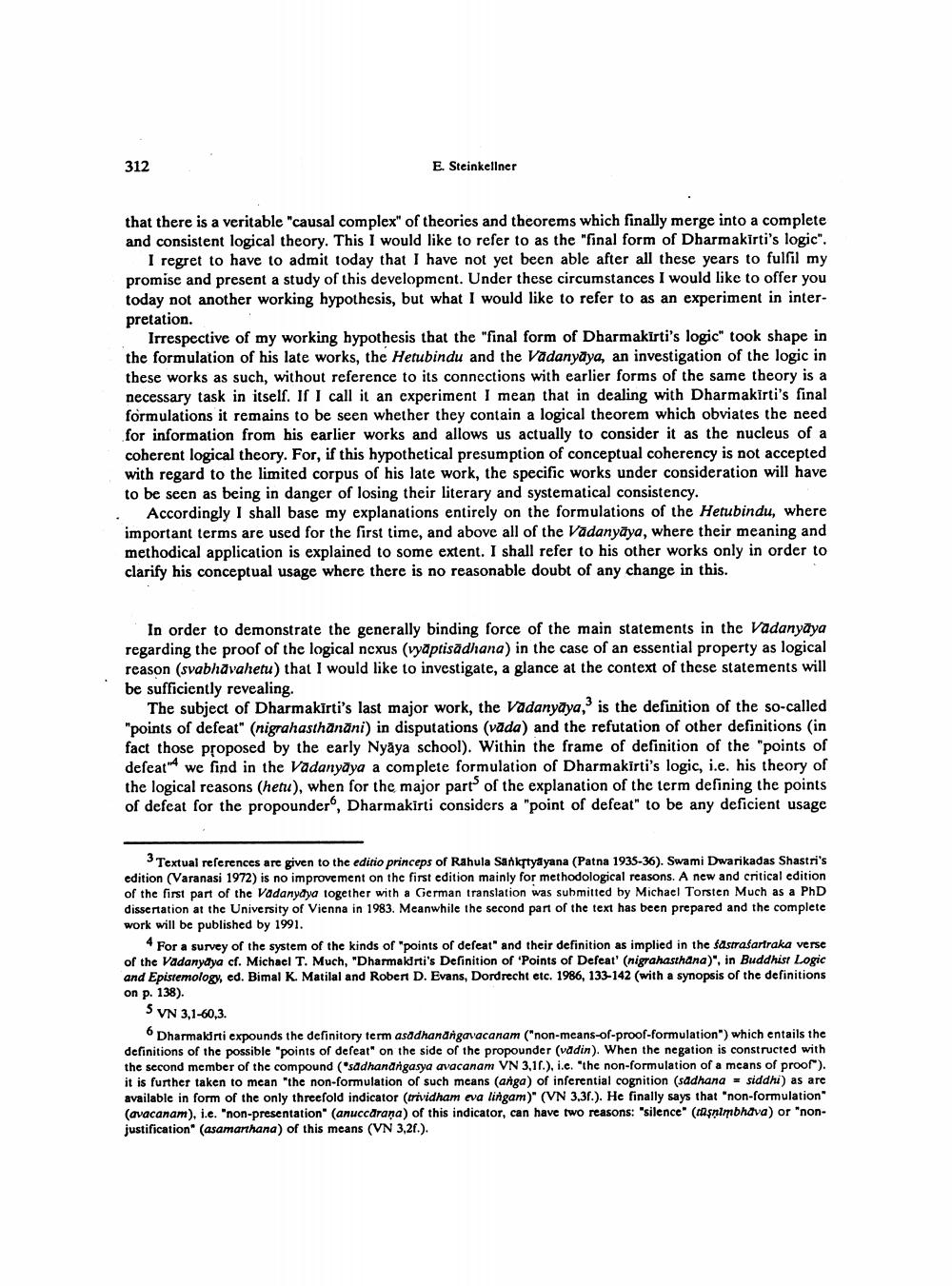Book Title: Logic Of Svabhavahetu In Dhharmakirtis Vadanyaya Author(s): Ernat Steinkellner Publisher: Ernat Steinkellner View full book textPage 2
________________ 312 E. Steinkellner that there is a veritable "causal complex" of theories and theorems which finally merge into a complete and consistent logical theory. This I would like to refer to as the "final form of Dharmakirti's logic". I regret to have to admit today that I have not yet been able after all these years to fulfil my promise and present a study of this development. Under these circumstances I would like to offer you today not another working hypothesis, but what I would like to refer to as an experiment in interpretation. Irrespective of my working hypothesis that the "final form of Dharmakirti's logic" took shape in the formulation of his late works, the Hetubindu and the Vadanyāya, an investigation of the logic in these works as such, without reference to its connections with earlier forms of the same theory is a necessary task in itself. If I call it an experiment I mean that in dealing with Dharmakirti's final formulations it remains to be seen whether they contain a logical theorem which obviates the need for information from his earlier works and allows us actually to consider it as the nucleus of a coherent logical theory. For, if this hypothetical presumption of conceptual coherency is not accepted with regard to the limited corpus of his late work, the specific works under consideration will have to be seen as being in danger of losing their literary and systematical consistency. Accordingly I shall base my explanations entirely on the formulations of the Hetubindu, where important terms are used for the first time, and above all of the Vadanyāya, where their meaning and methodical application is explained to some extent. I shall refer to his other works only in order to clarify his conceptual usage where there is no reasonable doubt of any change in this. In order to demonstrate the generally binding force of the main statements in the Vadanyāya regarding the proof of the logical ncxus (vyāptisādhana) in the case of an essential property as logical reason (svabhāvahetu) that I would like to investigate, a glance at the context of these statements will be sufficiently revealing. The subject of Dharmakīrti's last major work, the Vadanyaya," is the definition of the so-called "points of defeat" (nigrahasthānāni) in disputations (vada) and the refutation of other definitions in fact those proposed by the early Nyāya school). Within the frame of definition of the "points of defeat we find in the Vadanyaya a complete formulation of Dharmakirti's logic, i.e. his theory of the logical reasons (hetu), when for the major part of the explanation of the term defining the points of defeat for the propounder", Dharmakirti considers a "point of defeat" to be any deficient usage Textual references are given to the editio princeps of Rahula Sanktyayana (Patna 1935-36). Swami Dwarikadas Shastri's edition (Varanasi 1972) is no improvement on the first edition mainly for methodological reasons. A new and critical edition of the first part of the Vadanyaya together with a German translation was submitted by Michael Torsten Much as a PhD dissertation at the University of Vienna in 1983. Meanwhile the second part of the text has been prepared and the complete work will be published by 1991. For a survey of the system of the kinds of "points of defeat' and their definition as implied in the fastrafartraka verse of the Vadanydya cf. Michael T. Much, "Dharmakdrti's Definition of Points of Defeat' (nigrahasthana), in Buddhist Logic and Epistemology, ed. Bimal K. Matilal and Robert D. Evans, Dordrecht etc. 1986, 133-142 (with a synopsis of the definitions on p. 138). 5 VN 3,1-60,3. Dharmakdrti expounds the definitory term asadhanangavacanam ("non-means-of-proof-formulation") which entails the definitions of the possible "points of defeat" on the side of the propounder (vadin). When the negation is constructed with the second member of the compound (sadhanangasya avacanam VN 3,11.), i.e. the non-formulation of a means of proof). it is further taken to mean "the non-formulation of such mcans (anga) of inferential cognition (sadhana = siddhi) as are available in form of the only threefold indicator (trividham eva lingam)" (VN 3.3f.). He finally says that "non-formulation" (avacanam), i.e. "non-presentation" (anuccaraņa) of this indicator, can have two reasons: "silence" (simbhava) or "nonjustification" (asamarthana) of this means (VN 3,2f.).Page Navigation
1 2 3 4 5 6 7 8 9 10 11 12 13
